Duncan Whitley
About
Duncan Whitley is a contemporary artist and filmmaker, whose creative practice spans artists’ moving-image, documentary field recording and spatial sound installation. He is currently working as Filmmaker in Residence with Film and Television Studies until September 2023.
Duncan was trained in the visual arts, graduating from Kingston University with a 1st Class Hons Degree in Fine Art Intermedia in 1999. He has presented site-specific projects, audiovisual works and live multichannel sound works in the UK and internationally. His audiovisual works have been exhibited at Aesthetica Film Festival, Coventry Biennial, Cafe OTO, Flatpack Film Festival, Whitechapel Gallery, The Whitworth, Centro de Arte Experimental de UNSAM (Buenos Aires), Monte (Buenos Aires), Museo de Bellas Artes Salta (Argentina), EMASESA (Seville), Serralves Museum (Porto), the Herbert Art Gallery & Museum, b-side Festival, and CTRL_ALT_DEL sound art festival (Istanbul).
(Scroll down to below blog content for examples of recent work)
Filmmaker in Residence
I am working as Filmmaker in Residence at Film and Television Studies for research and development of a hypothetical film project, “Vanishing Point”, to explore themes of movement, migration and loss through an experimental ‘British road movie’. The project will develop through interdisciplinary research and experimental film production over the residency period. The first phase of research consists in two broad strands: migration studies, through exchange and collaboration with members of the Borders Race Ethnicity and Migrations (BREM) network; and cinema studies, with the aim of deconstructing the road movie as part of a process leading to a nonlinear, digital storyboard. Phase two research will focus on writing, experimental storyboard processes and technical development, which in principle will lead to production work across the final phase of the residency.
Residency Blog
[October 2022]
The first phase of development through the residency at Film and Television Studies involves two broad strands of research:
- Film studies research, looking at key tendencies of the ‘road movie’ or ‘journey’ genre of cinema (including narrative tendencies, cinematography, the role and meanings of landscape), to arrive at an expanded definition of the genre.
- Migrations and borders research, looking at the ideologies, media narratives and realities of the precarious movement of people (in particular post-2015, in the context of the so-called ‘European migration crisis’ and the UK European membership referendum), and how they come to define British, and in particular English, national identity through processes of statecraft.
These research strands represent two of the key areas which will inform the development of Vanishing Point, and reflect the driving interest behind the project to explore the potential of the ‘road movie’ (in its expanded definition) to ‘speak to’ a particular mood of contemporary Britain. Although Vanishing Point will look and feel different, I’m thinking of this film as a companion piece to my penultimate film. Kimberlin. Kimberlin, whose title is a dialectal word for "a person living on the Isle of Portland who does not descend from a lineage of at least two generations of Portlanders, or by extension, a foreigner or stranger", explored the idea of belonging through the particular landscape of the Isle of Portland. Although the film is full of local references, it was produced in the period following the European Union membership referendum, extending the metaphor of island-ness to the United Kingdom (and England in particular). In a similar way, Vanishing Point will be developed in the context of the current high-profile communications around Home Office immigration policies, with their conjuring of Churchillian war-time rhetoric.
In the second phase of the residency I plan to begin writing the film (although there will be some overlap and fluidity between research phases). This 'writing' will develop through a number of parallel processes, one of which will involve the development of a non-linear digital storyboard, extending directly from the phase one film studies research, by feeding analyses of shot composition and camera movements into a storyboarding process in which film analysis and writing meet. This will take place alongside a screenwriting process which I propose to develop through a series of workshops with (non-professional) actors.
[November 2022]
The first research strand of Vanishing Point has been focused on gaining a broad understanding of some of the key issues around migration and border politics explored by members of the interdisciplinary Borders Race Ethnicity and Migrations (BREM) network. This work will continue into (at least) December, through reading, meetings with a group of researchers from BREM and experimental image work. One of the key observations which feels pertinent to the development of Vanishing Point, is that experiences of cross-border migration are typified not only by movement but by dead-ends, stasis and containment. Time may not be that of the linear trajectory suggested by the image of the vanishing point of the iconic long, straight road (emblematic of the ‘road movie’ - in particular its North American genus) but rather are often characterised by stranger experiences of time or timelessness, for example in the limbo status of people seeking asylum in the UK without access to right or resources of citizenship.
What is also clear is the consensus that there is no one experience of cross-border migration, and no one 'typical migrant'. This should be a common-sense statement, but the voices coming from UK politicians, mainstream media and even from well-intentioned human-rights NGO's are intent on creating overly simplistic, singular images of the trans-national migrant. In his Illegal Traveller: An Auto-Ethnography of Borders (2010), Sharam Khosravi describes the ways in which the stories of refugees are often not believed by officials if they do not conform to a particular universalised image of 'refugeeness'.
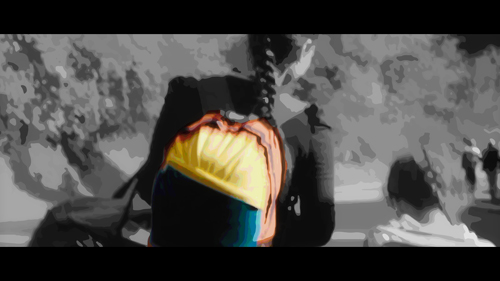
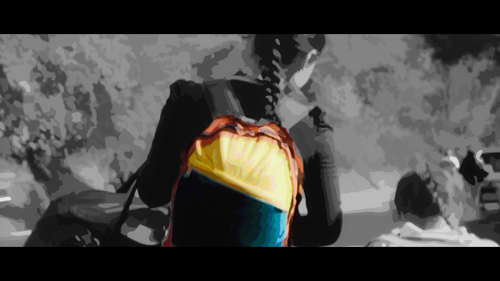
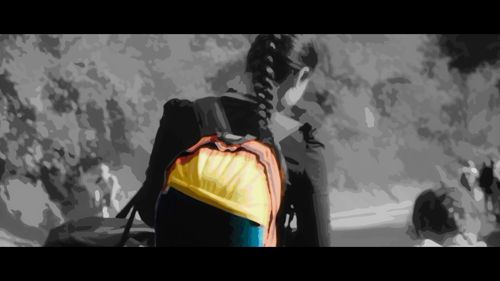
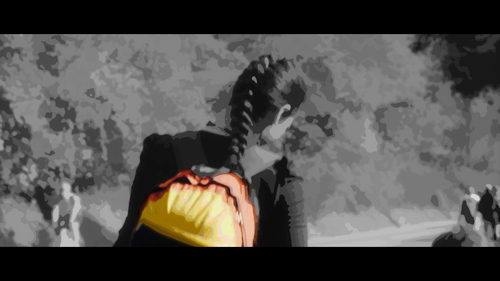
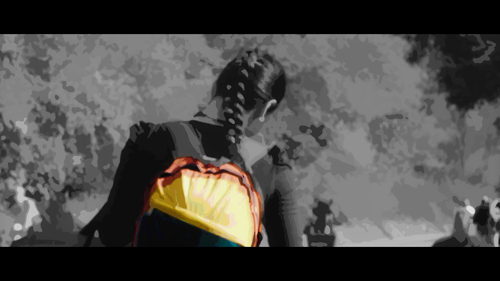
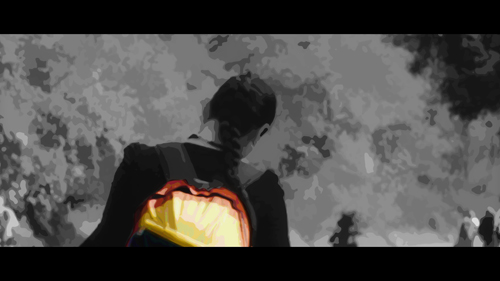
Above: an image sequence from experimental work exploring techniques and aesthetic avenues for working with and transforming found footage. This particular sequence came out of conversations Mauricio Palmer-GutiérrezLink opens in a new window about the meanings of the "morralito tricolor": a rucksack bearing the colours of the Venezuelan flag, originally distributed free to schoolchildren and now commonly used by Venezuelans to carry personal belongings during cross-border migratory journeys.
[December 2022]
Experimental practice: Why bother storyboarding?
One of the ways that I propose to make experimental practice central to my residency project is, counter-intuitively, by studying more conventional methods of writing film through the practices of screen-writing and storyboarding. Within the framework of my film-making practice this feels radical: I have never ‘written’ a film, I cannot draw, and I have never produced a screenplay, script or a storyboard to assist production.
I tend to have a vision of what I want to do and how I plan to do it which centres on a series of ‘spaces’ that I’ll need to tell a story - these spaces might be specific images, complete scenes, or simply types of image, movements or moods - but with no exact plan as to how these will fit together to create the story. The process of ordering images into sequences to create a narrative shape takes place in the edit, and I begin to edit during the production phase (and also continue to shoot images where necessary during post-production). Soundtrack production runs in parallel to this fluid production-post-production visual workflow, influencing the narrative form of the film as much as supporting it. Working with composer Guido Zen (AKA Abul Mogard), our collaborative and creative workflow involves a to-and-fro of visual and aural ideas, taking place materially through an exchange of production rushes and musical sketches which inform and influence one another. For this reason, it’s been important to date that initial soundtrack production with Abul has developed during production phases of a project, with the soundtrack and visual edit beginning to converge through post-production. It takes longer than the conventional workflow in which a ‘locked-off’ picture edit gets sent to the sound department, but the process is important to me as it allows sound to influence to shape and duration of the film, thus challenging the image-to-sound hierarchical relationship which dominates the audiovisual medium in both film and television.
The proposition of placing experimental storyboarding and writing processes at the heart of Vanishing Point serves several functions. On one level, ‘writing’ a film proposes a pragmatic approach to developing a work that will evolve through multiple storylines: separate narratives played out by different characters, stories which don’t explicitly interact but which obliquely collide as co-existent spaces through an overarching narrative form, in what might loosely be described as a ‘hyperlink’ structure. What I am more interested in however, is how a storyboarding process might be used to bring film analysis (based on archival research) and writing into creative research-writing-filmmaking process.
[January 2023]
Wanda, Wendy, Amanda and others on the edge
The idea of the vanishing point is on the one hand emblematic of the road and its associated landscapes, telegraph poles and electricity pylons cutting across the swathes of countryside. Its converging parallel lines on the horizon suggest a destination, a movement towards, a journey (even if we can never really arrive at that illusory point of convergence). Whilst I intend to come back to themes of movement and vision, and their metaphoric connections with the journey - it is impossible to ignore that the camera movements in today’s cinema still use tracks, a mechanism whose origins trace back to George Albert Smith’s A Kiss in the Tunnel (1898), in which a camera was affixed to the front of a train - I am concerned here with a different reading of the phrase ‘vanishing point’, as suggestive of invisibility, a being outside of society. Beyond its beat romanticism, being on the road can be read as a being between places: a space of vulnerability or precarity. In the UK, the 1824 Vagrancy Act which makes it a criminal offence to sleep rough is still in force today, and is regularly used both formally and informally by UK police. The practice of ‘squatting’ was made illegal in the UK in 2011, through section 144 of the Legal Aid, Sentencing and Punishment of Offenders Act. The Police, Crime, Sentencing and Courts Act 2022 criminalises trespass, and is anticipated to impact on the lives of Gypsies, Travellers and others who live a nomadic lifestyle, whether by choice or by necessity. These state practices make it disturbingly easy for lives to fall into spaces of precarity, to disappear from view (of mainstream society).
There are a number of significant independent ‘road’ films whose stories revolve around individuals whose lives fall between the gaps of Western society, notably: Wanda (Barbara Loden, 1970), Vagabond (Agnés Varda, 1985), My Own Private Idaho (Gus Van Sant, 1991), Wendy and Lucy (Kelly Reichardt, 2008) and American Honey (Andrea Arnold, 2016). These films are amongst a group of works which I’m interested in as reference points for the writing of Vanishing Point, through an experimental process which will use film analysis as a tool for screenwriting and storyboarding.
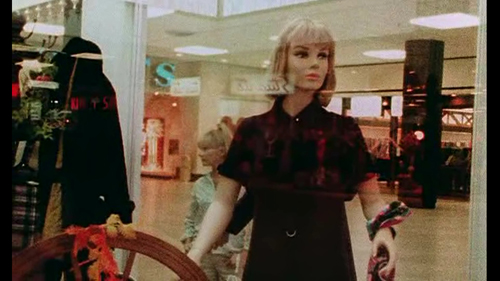
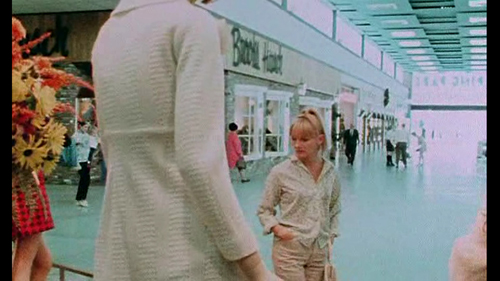
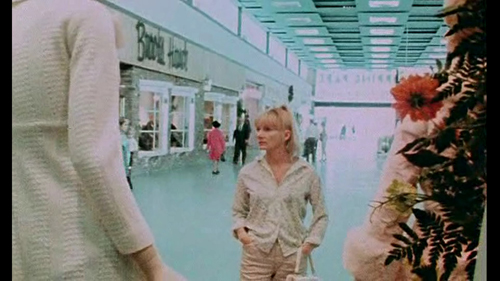
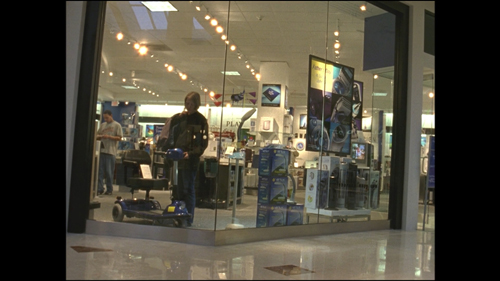
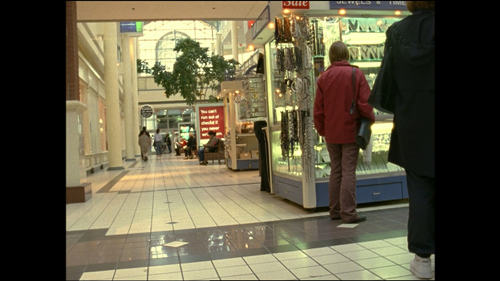
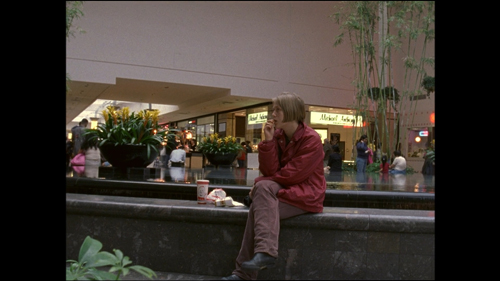
Upper row: Wanda (Barbara Loden, 1970). Lower row: Chain (Jem Cohen, 2004).
In this early stage of phase two research/ pre-production, I’m working on a comparative analysis of three ‘road films’ - Barbara Loden’s seminal Wanda, Kelly Reichardt’s Wendy and Lucy, and Jem Cohen’s Chain (2004). All three films were shot on 16mm (albeit with different aspect ratios), and all three follow a lone female character in the United States - two in the case of Cohen’s Chain, whose stories have no real overlap, one a Japanese business woman who moves from hotel to hotel in the course of business, the other, Amanda, a runaway haunted by credit card debt who moves from place to place to avoid collection calls - but beyond this the choice of films might initially seem arbitrary, guided more by intuition than by strict criteria. These three films form the basis for this process, but the methodology allows the fluidity for me to bring in further references, for example: Vagabond, American Honey, Leave No Trace (Debra Granik, 2018), Nomadland (Chloé Zhao, 2020), Cathy Come Home (Ken Loach, 1966), and others. In this way, the process will allow me to analyse particular types of representation, through an observation of commonalities and typologies (and their differences).
The process is a visual one, taking place within the editing environment, identifying loose scene typologies (e.g. figure in landscape, sleeping figure, campfire, cafeteria scene, etc) and subsequently breaking down their functions and meaning through further analysis. The aim is to develop elements for a non-linear digital storyboard, out of which Vanishing Point may begin to take shape. The methodology is flexible and intuitive, in the same way as my usual editing process would be: responsive to the collision and resonances of abutted images, to rhythm and coincidence, shapes and forms. The approach is also an inherently hypertextual practice, bringing together a series of unconnected stories into a visual flow, which can feed into screenwriting development for Vanishing Point. Specifically, the focus on Wanda, Wendy and Chain form part of creative research into one of Vanishing Point’s prototype parallel storylines, which orients around a young, female protagonist.
[Note: as the project took shape over subsequent months it became clear that the film will not use actors, nonetheless both the hypertext form and the ideas around precarity explored through this process remain central to Vanishing Point].
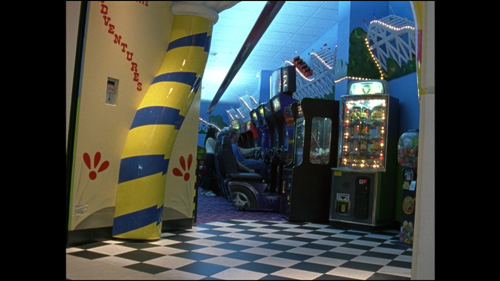
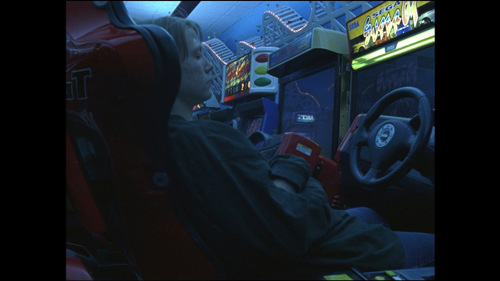
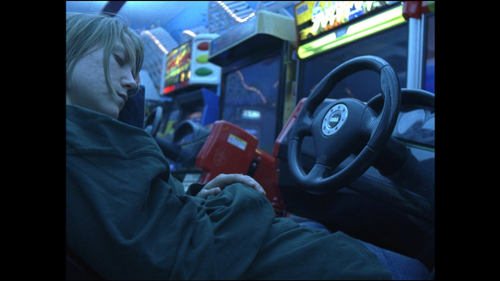
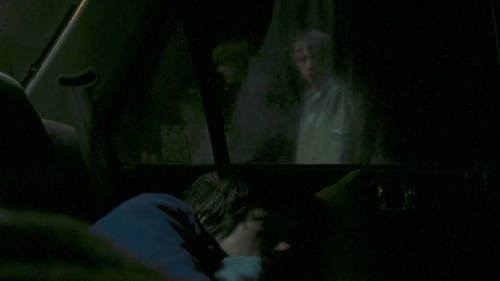
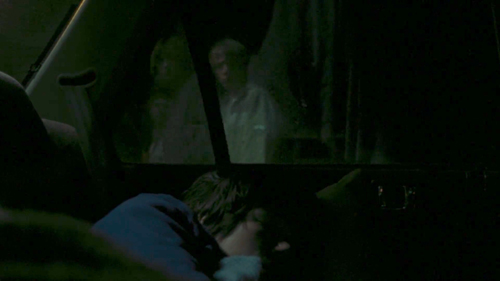
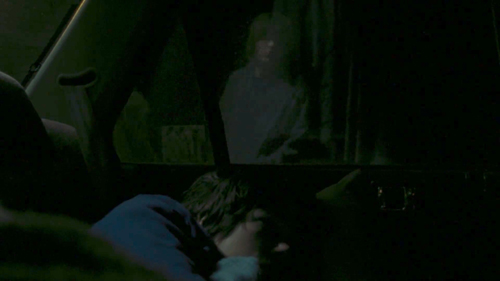
Upper row: Chain (Jem Cohen, 2004). Lower row: Wendy and Lucy (Kelly Reichardt, 2008).
[March 2023]
Thinking through the lens
From mid-February I began shooting some landscape images as pre-production tests for Vanishing Point. I had hitherto been holding back from working with the camera, because I had some loose threads of stories at this stage but they were not yet developed enough to shoot. However, since I knew that I wanted to work with winter landscapes in this project, I was working with a limited timeframe to get something shot (whilst still in residency at Film and Television Studies).
I didn’t have a conventional storyboard sketched out, but I was guided by some threads which were beginning to consolidate from the previous research phase based on a comparative analysis of Wanda, Chain, and Wendy and Lucy, and a wider set of films including (Agnés Varda, 1985), Cathy Come Home (Ken Loach, 1966), American Honey (Andrea Arnold, 2016), Nomadland (Chloé Zhao, 2020), The Levelling (Hope Dickson Leach, 2016), Leave No Trace (Debra Granik, 2011), Children of Men (Alfonso Cuarón, 2016), and Gerry (Gus Van Sant, 2002). Particular motifs from this research provided a starting point for locations and ways of shooting them: for example, scenes from Last Days (Gus Van Sant, 2005) and Wendy and Lucy, which place their lone protagonists in the rural edgelands surrounding the railway tracks. Van Sant has his fictive Kurt Cobain (played by Michael Pitt) traipse through the brambly undergrowth dressed in t-shirt and sodden Converse sneakers, pausing to look up at the freight train which cuts through the woodlands closeby, the travelling camera voyeuristically looking down through the branches to observe this scene. In Reichardt’s film, Wendy (played by Michelle Williams) arrives at the small town where she will lose her only companion, her dog Lucy, travelling alongside the railway tracks. Again the camera looks through trees and undergrowth (throughout the film we will return to images of Wendy walking along the railway line through woodlands on the edge of town). Whilst my camera would not be tracking actors, these images provided a starting point in terms of types of landscapes and how they might be made to speak about ‘being outside’ or on ‘the vanishing point’ of society (a state or space in which both Reichardt and Van Sant depict their principle characters).
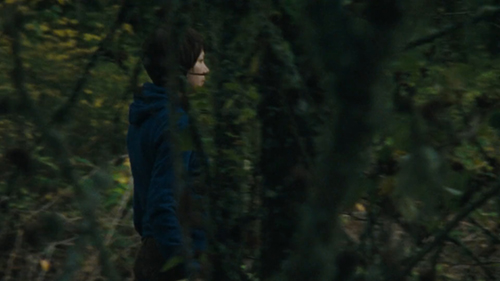
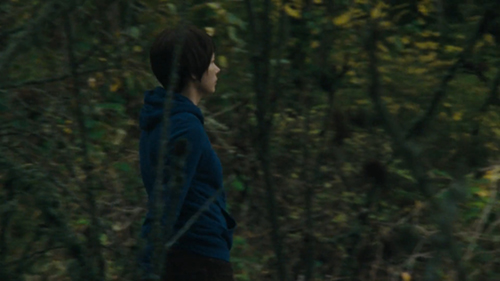

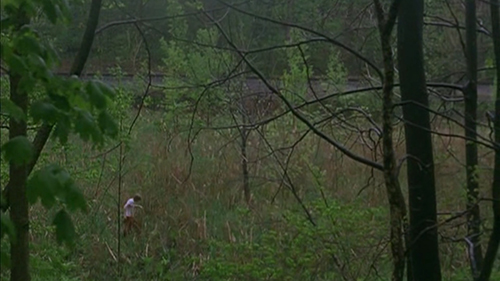
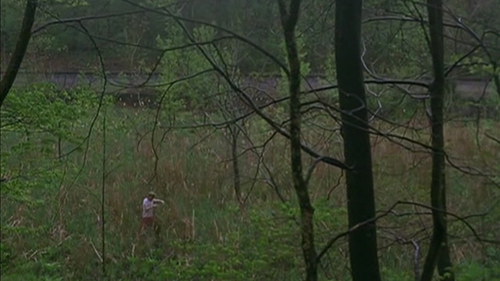
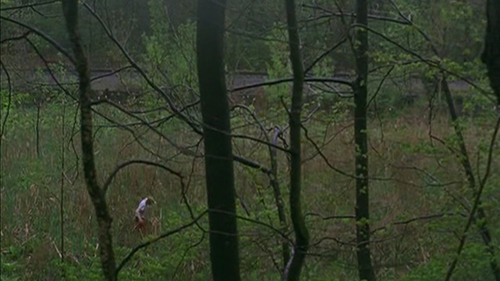
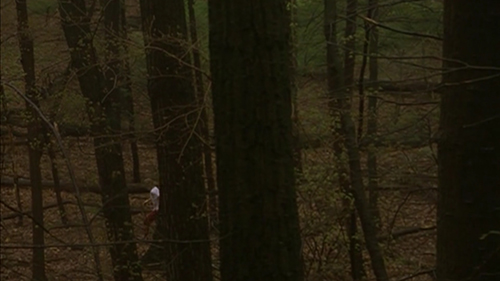
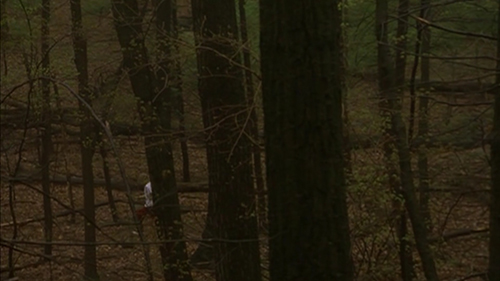
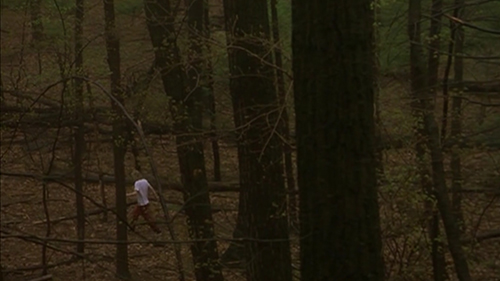
Upper row: Wendy and Lucy (Kelly Reichardt, 2008). Middle and lower row: Last Days (Gus Van Sant, 2005).
The idea was to combine location research with carrying out some test shots, and from there to start defining framing and shot styles, types of camera movement and other cinematographic elements. Working alone with a tripod, camera and small selection of lenses, I can take a slow, observational approach to exploring landscapes, shooting over as many days as necessary - as and when the weather provides the ideal conditions. Exploratory in nature, the process is not particularly economical but I feel that it allows me to think and feel through the camera lens, in the landscape. This haptic space is where research ideas (see the previous entry, Wanda, Wendy, Amanda and others on the edge), technical development and the physical landscape begin to collide and synthesise.
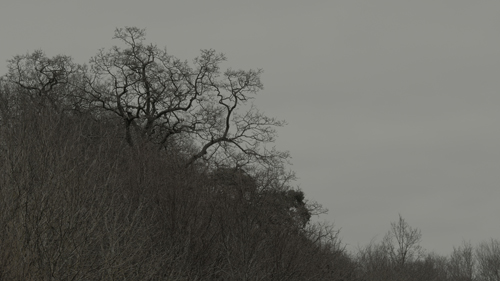
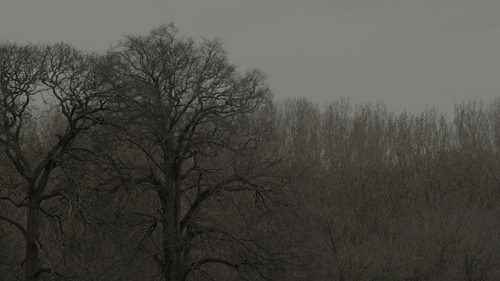
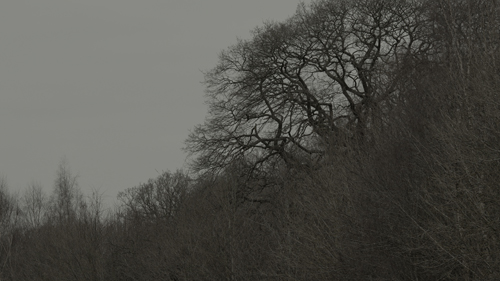
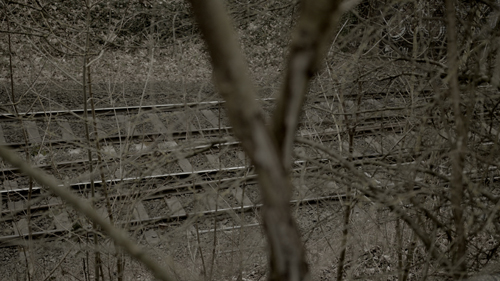
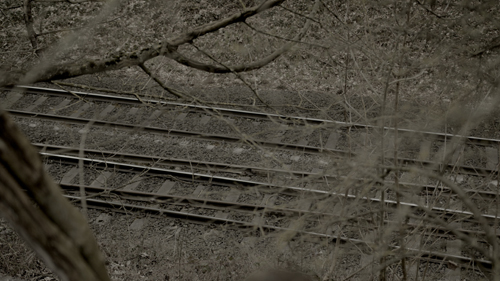
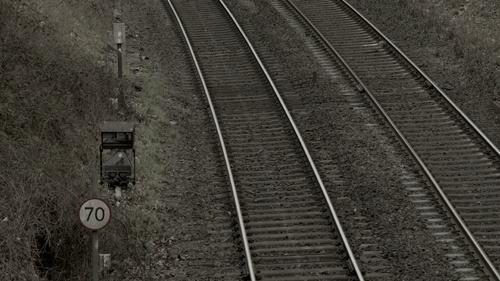
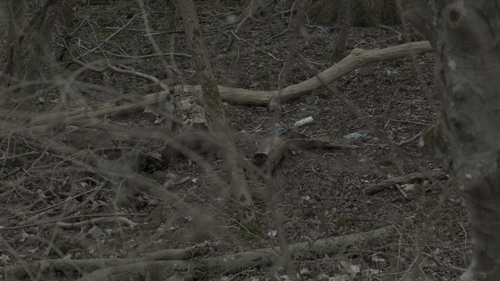
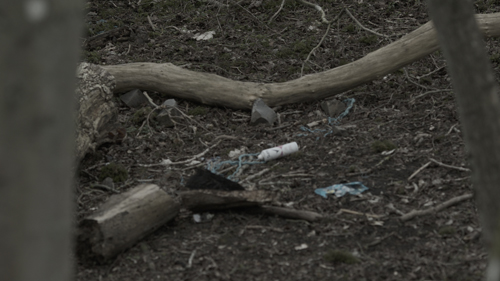
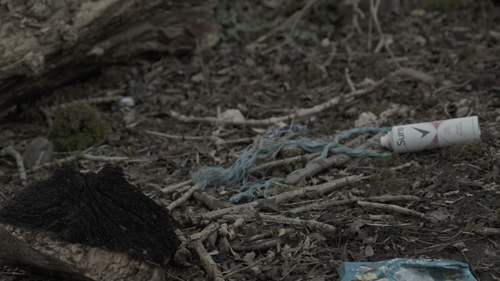
Above: Images shot during pre-production tests in Warwickshire.
I’m looking at paths, broken fences, railway tracks, old stone bridges, and out-of-the-way corners of woodland where it's evident people have been camping- traces of human existence in the rural edgelands. I begin work around the fields, footpaths and bridleways of the parts of South Warwickshire where I grew up, because my existing knowledge of some of these spaces makes it easier for me to find what I’m looking for, although much has changed over the decades. I also begin here because I am curious about the many spaces, now fenced-off and under ownership of the HS2 high-speed railway scheme, which now characterise the area. I am not particularly looking at HS2 in the scheme of Vanishing Point, but it feels interesting to be working in and around these highly contested spaces- in fact, filming here has been complicated on a practical level by the new borders and security infrastructure in place throughout nearly all the places I have been working. HS2 and the protests which sprang up in attempts to halt its progress across this part of the Warwickshire countryside, have seen these pleasant rural spaces become highly securitised, as illustrated by this Staffordshire farmer, who describes the treatment of protestors who occupied a woodland close to the HS2 route: “It wasn’t just 10 or 20, but 200 security who looked like paramilitaries. They fenced in the protesters, and ambulances and climbing crews and diggers sat there waiting outside for about 30 days.” (Source: The Guardian, ‘I’ve gone through bereavement’: HS2 bought this man’s land, and for what?’, 06/10/23). In the same interview, this farmer mentions that HS2 employed security dogs in a woodland under his ownership (without asking his permission to do so).
This again forms part of processes of ‘thinking through the lens’ and ‘being in the landscape’ which guide some of the mood and direction of Vanishing Point, not always in direct or literal ways, but as a kind of immersion which infuses the ways of looking, meanings of landscape, and even some of the potential ‘storylines’ of the film.
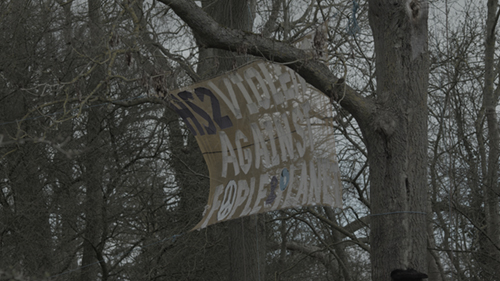
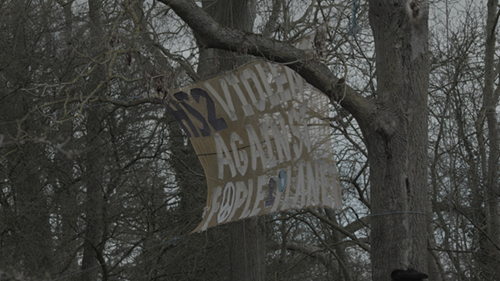
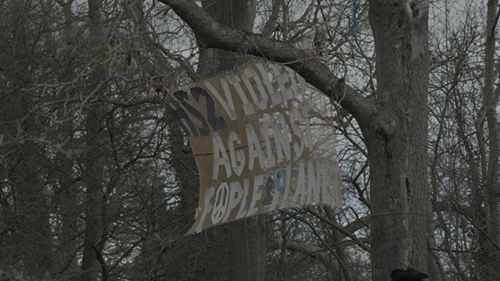
Above: Protest banner at the Welsh Road Protection Camp, near Southam. Shot during pre-production work in Warwickshire.
[April 2023]
Dover
During meetings with a conversation group consisting of members of the BREM (Borders Race Ethnicity and Migrations) network, we had talked about various themes around border politics which might lend themselves to exploration through film. We talked about border spectacle, on the one hand, with its media motifs and volatile symbols, and on the other the invisibility of the border and its manifestations beyond the collective imaginary, and how might the (this) border be made visible? These conversations around the borderscape and border aesthetics indirectly circled around a broader theme of ‘seeing politics’ and how the medium of film might facilitate “showing rather than explaining politics… [showing] the shifting dynamics of informal politics and the relationship between structure and agency in ways that the written word cannot” (Sophie Harman, 2019, ‘Seeing Politics: Film, Visual Method, and International Relations’).
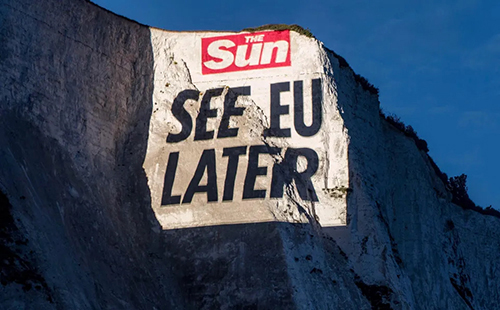
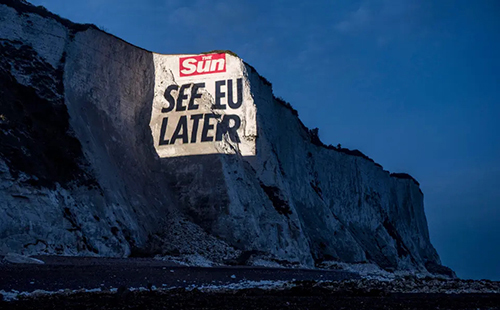
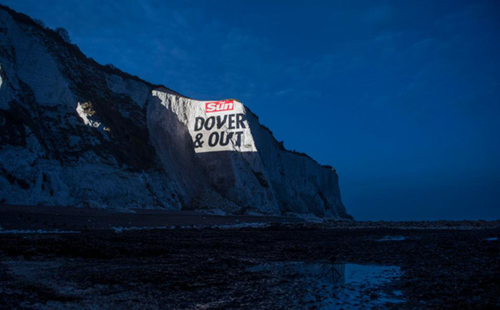
The idea to travel to Dover with the camera (accompanied by Sylvester Shlebruegge from the group) surfaced through these conversations, and like the test shots I had been working on in Coventry and Warwickshire was speculative, with a focus on observation through the lens. I had established a fair sense of some of the ways I was interested in looking at landscapes, and a broad aesthetic with which I was working, so the principle goal of test shots in Dover was to answer the questions: can I shoot Dover in the same ways that I’ve been shooting rural edgelands in Warwickshire? (i.e. can I achieve a coherent aesthetic approach to the two locations?) And if so, what complexities might this aesthetic approach bring to the surface that go beyond, or even provide counter to, popular border narratives.
I met with Sylvester ShlebrueggeLink opens in a new window from the conversation group down at Dover, with the idea of exploring the landscapes together. Silvester’s research looks at how the imagined border becomes real (sensed), within the context of the so-called ‘Channel migrant crisis’. The recce combined the lugging of heavy tripods with a backdrop of conversation around these themes, whilst looking for locations and potential shots. There was a lot of looking but not shooting, as an early morning shoot looking down at the port was marred by almost impenetrable fog and drizzle, but we identified a number of locations along the cliff tops and down on Samphire Hoe, a nature reserve created from the overspill from the digging of the Channel Tunnel, with its train tracks running at the foot of the cliffs.
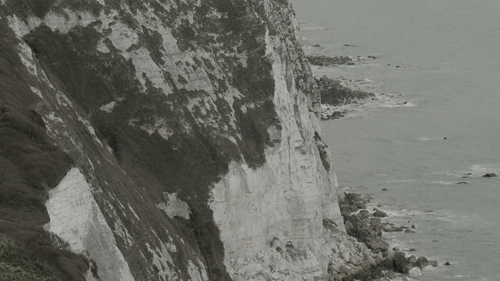
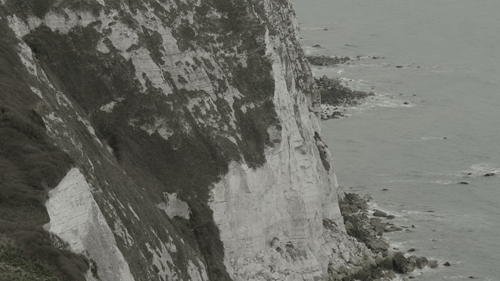
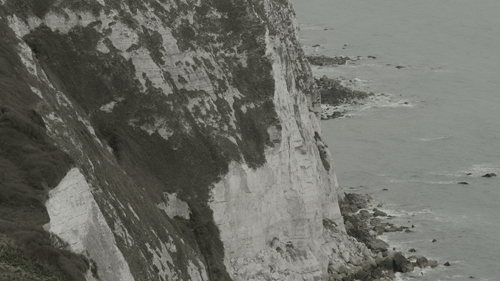
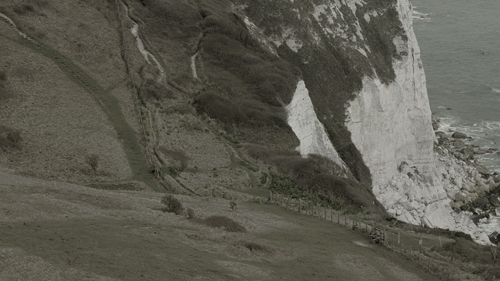
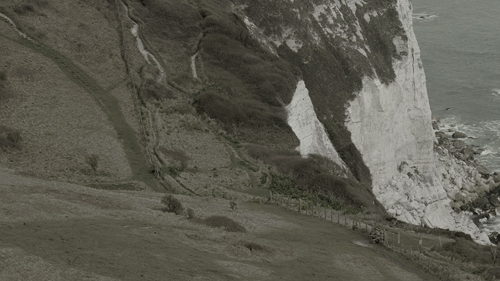
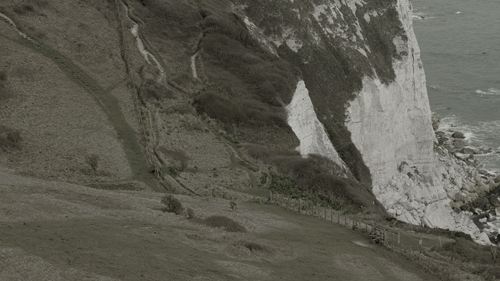
Above: Stills from pre-production test images shot in Dover.
Once the drizzle had ceased I managed to spend some good time framing shots looking down into the port from above: it’s architecture, and forms created by the vehicles and goods moving through it. It’s sometimes only by looking through the camera lens that you consciously begin to understand what you are looking for, as a concept starts to form around the image. Seeing the framed image of an overcast Dover port allowed me to reflect on the interconnections between the conversations with Syvester and, for example, images from Wendy and Lucy. In Wendy and Lucy, the opening credits consists in a series of four shots in which freight trains cut through the frame at various angles, but this is not just setting the scene for the main protagonist who next appears walking with her dog alongside the tracks: her film Certain Women (2016) opens with a single shot lasting 1’34”, in which a freight train appears out of the vanishing point of a wide-framed landscape; and her film First Cow (2019) opens with a single, static shot in which enormous freight ship takes a full 1’16” to traverse the frame. This persistent image which Reichardt returns to (it is more than a motif, it is as if she continues to explore the same image in search of something unresolved), gives the individual scale. Jem Cohen’s Chain does something similar with his characters, who are observed in the slow, mundane detail of their lives, each with some level of agency but humbled against the scale of global capitalism. Looking through the lens, the freight moving through Dover port’s various queuing systems, ramps and barriers begins to talk about the border in a way that reveals scale (beyond the individual), and which might enable us to ‘see politics’. (Of course, the image of huge queues of lorries at Dover became associated symbolically with ‘Brexit’, visualising the border through the inertia of trade there).
I didn’t exhaust the work I would have liked to do in Dover, but the visit satisfied my goal of testing whether I could make the landscapes of Dover work within the aesthetic scheme of Vanishing Point. And further, that being in the place (observing through camera practice) is to understand these symbolically complex landscapes through a sensory as well as cognitive process.
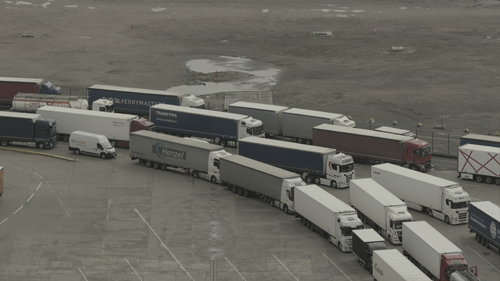
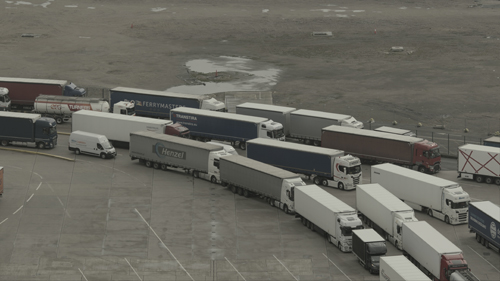
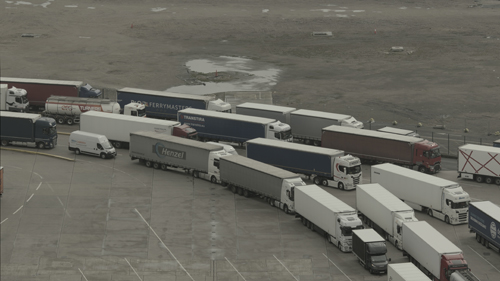
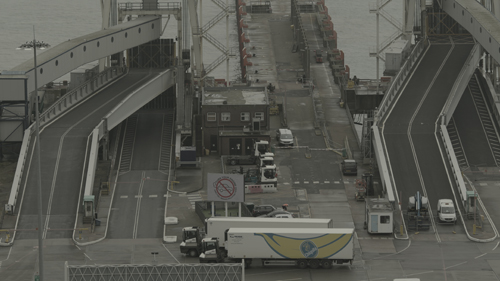
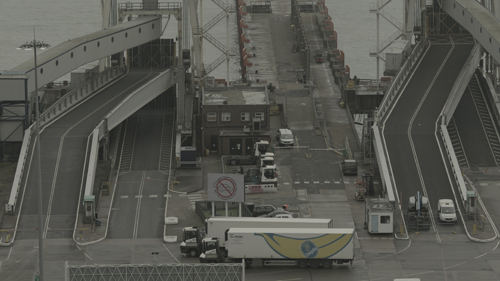
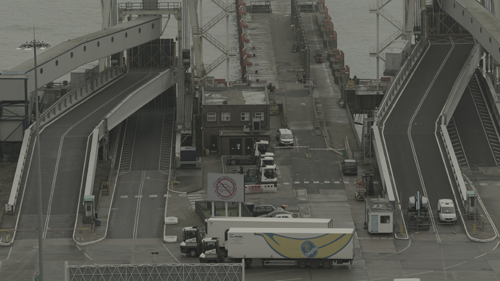
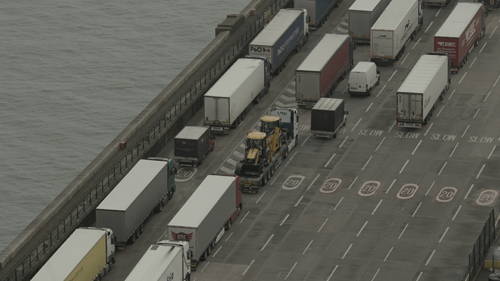
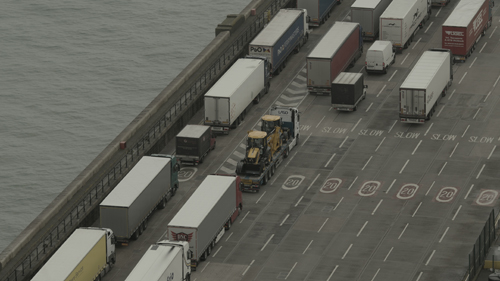
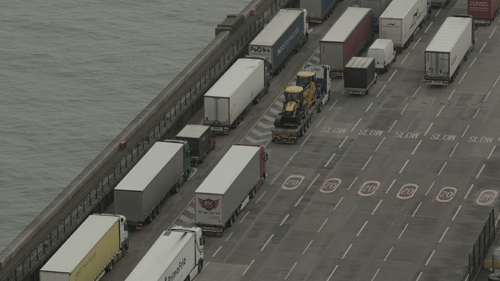
Above: Stills from pre-production test images shot in Dover.
[August 2023]
Observing the Bibby Stockholm
Seeing the Bibby Stockholm accommodation barge in its berth at the Isle of Portland, reveals more about it than can be gleaned from the raft of front page news articles in the national press, since the ship’s arrival in Portland on 18th July 2023.
Portland is a small island with a population of 13,417, attached to mainland UK by a tombolo which supports the only road on and off the island. It is home to one of the largest human-made harbours in the world, and also to a people fiercely proud of its local heritage and customs, of whom almost 94% are white. Since the UK government announced its plans on April 5th 2023 to house 500 asylum seekers on a floating barge docked at Portland Port, communities on Portland have been unsurprisingly concerned about the proposals, with a number of discussion groups forming on Facebook and other social media platforms, dedicated to sharing information about the Bibby Stockholm. Whilst many people living locally expressed concern for the well-being of the future inhabitants of the accommodation ship, responses to the announcement also channelled anti-immigrant sentiment, often echoing the language used by the then Home Secretary Suella Braverman, who has repeatedly used the term “invasion” to paint a picture of an “existential threat” posed to British values and culture by “illegal immigration”. Weymouth and Portland have since become a focus for far-right groups such as Patriotic Alternative, with local councillors and businesses receiving threatening letters (allegedly from members of Britain First). The berthing of the Bibby Stockholm off the Isle of Portland has thus become a focal point of both local and national debate, polarising opinion and heightening sensitivities around immigration and border politics and nationhood, and feeding into a toxic post-Brexit atmosphere of nationhood.
The Bibby Stockholm is only visible from the Verne Citadel, now HM Prison The Verne, built in the late C19th to protect Portland Harbour which it overlooks from a hill on the north-east side of the island. The floating barge is moored off a L-shaped jetty in Portland Port, a privately-owned commercial space serving military vessels, cargo vessels and cruise ships. Across on the next jetty an ocean liner is moored, billowing smoke from its huge stacks, and further up from that a pair of Royal Navy warships. Small tugs and Portland Port Police boats move through the waters surrounding the accommodation ship, contributing to the low frequency rumble of ship engines which emanate from the harbour down below. Alongside the barge is a large, industrial structure housing a crane, which is used to load and unload goods from arriving cargo ships. Across on the opposite jetty is a warehouse, and other port furniture, the scale of which comes into focus through the port workers in their hi-viz jackets who appear like ants from the viewing point up by the Verne. Way beyond the jetties and enclosing the harbour to the east is the Portland Breakwater, with its array of disused military buildings once occupied as searchlight emplacements, gun and mine-watching posts. The construction of breakwaters began in 1849, following the building of HM Prison Portland (now the Young Offenders Institute) to provide human labour for the project, with convict labour providing 10,000 tons of stone per week for use on the breakwaters.
Coincidentally, the Bibby Stockholm is moored in exactly the same location as Portland’s controversial prison ship, HMP Weare, was once berthed. Operating as an adult male Category C prison until 2006, HMP Weare was sold to the UK government by British company Bibby Line in 1994 (the same business, now renamed Bibby Marine, who currently lease the Bibby Stockholm) who had bought the vessel in 1982 and named it ‘Bibby Resolution’. Stood outside the walls of HMP The Verne, scanning down into the port beyond the naval cemetery, these multiple histories begin to form a strange poetry of place, which informs the austere architecture of the floating accommodation ship below.



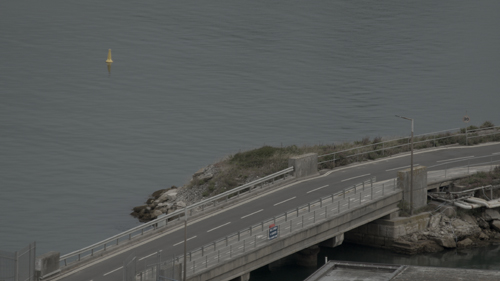
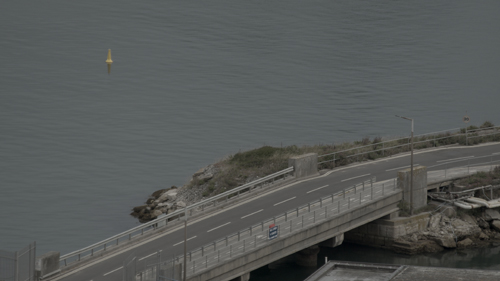
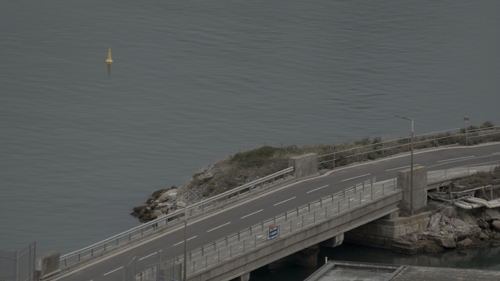
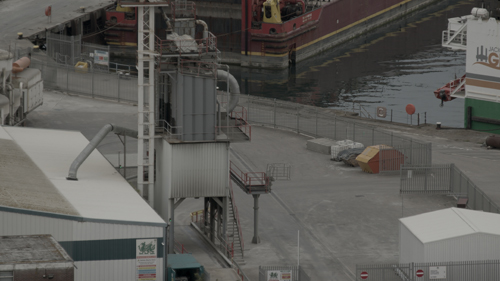
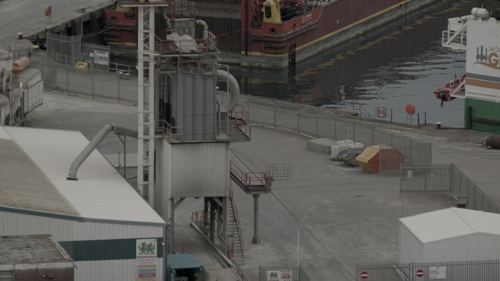
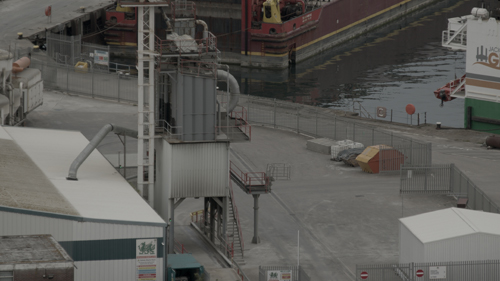
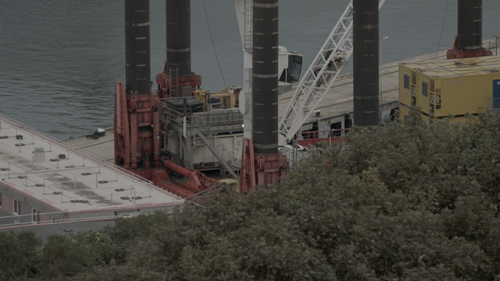
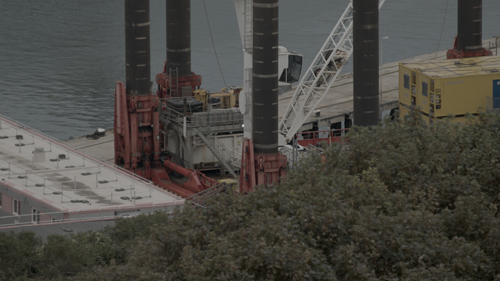
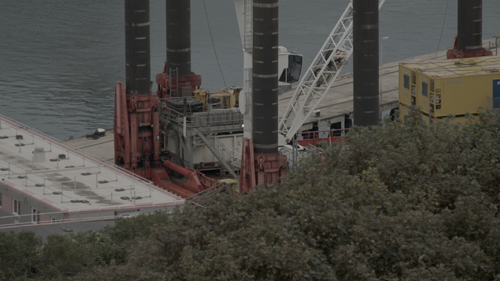
Above: Stills from pre-production test images shot in Portland, looking down into Portland Port.
The closest you can get to the Bibby Stockholm on foot is the entrance to the highly-securitised Portland Port from Castletown. When I visit in the evening, the Castletown neighbourhood feels eerily quiet. There is no one in the streets, just a group of teenagers amusing themselves by the mariner and the occasional roar of a lone car revved up to the max. Although the area has undergone a deal of regeneration in recent years, it is still haunted by the skeletal, concrete ex-naval accommodation block, which conjures images of Castletown’s busy, bustling past. With the naval communities long gone, the area feels rather remote from the rest of Portland and not particularly homely.
The inhabitants of the barge are permitted to go outside at any time, but as soon as they step off the ship they are in a securitized zone. According to Portland Port, “when on port property they will be kept on the Bibby Stockholm or in a secure compound adjacent to the barge” (‘An Open Letter to Bibby Marine’, Refugee Council, July 2023). In recent Guardian article, one inhabitant on the barge is quoted as saying, “Even to use the fresh air, you have to go through the inspection every time and go to the small yard with high fences and go through the X-ray machine again” (‘This is a prison: men tell of distressing conditions on Bibby Stockholm’, Guardian, October 2023).
If the Bibby Stockholm looks and feels like a prison, it is not entirely accidental (and in fact, the accommodation of asylum seekers in quasi-detention sites is not unique to the Bibby Stockholm, see for example Napier Barracks in Kent). Rather, it forms part of a wider set of punitive government policies which seek to cast asylum seekers as “illegal migrants” who would drain the resources of the British tax-payer, aligning with the creation of a “hostile environment”, in the words of Immigration Minister Robert Jenrick, “to prevent the UK becoming a magnet for asylum shoppers in Europe” (Home Office, 2023). The inhabitants of the accommodation ship face a double-hostility, firstly that of the actual living conditions through being housed in a private commercial-industrial-military securitised zone, with its heavy fuel-laden air and constant industrial noise, and secondly that of the perceptions with which they are met on the island, since this spectacle of detention symbolically evidences the asylum seeker as “illegal” or “criminal”. Thus the visiting men who will be temporarily accommodated on the Bibby Stockholm whilst awaiting the outcomes of their Asylum claims, are placed into tense relationships with the local community through being cast as (literally) peripheral to society, if not as an actual “threat” to local communities.
Recommended reading: ‘Bibby Stockholm: The Political Economy of Offshore Asylum Accommodation and Confinement’, Turner, J. Davies, T. Isakjee, A. Mayblin, L. Yemane, T. (2023)
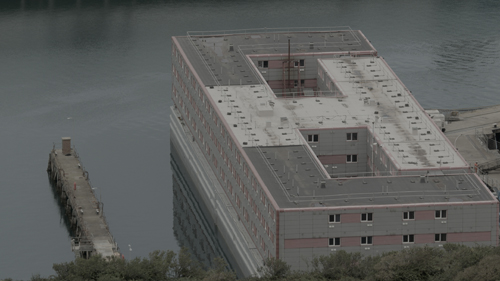
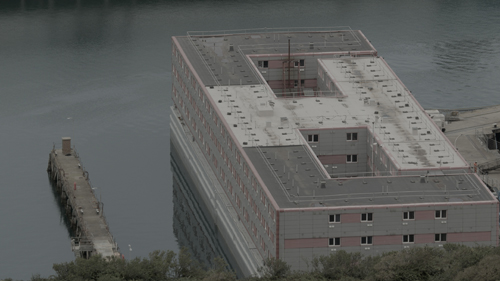
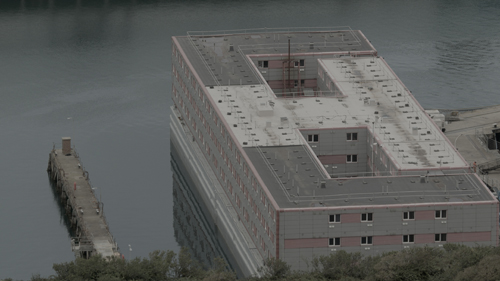
Above: Looking down at the Bibby Stockholm from HMP The Verne. Still from Vanishing Point pre-production/ research.
[Nov 2023]
Observations on a year of research in residency at Film & Television Studies
We rounded up the residency with a screening event and Q&A with Dr. Michael Pigott (artist and Associate Professor at Film and Television Studies) at the Faculty of Arts Building cinema. This was an opportunity for me to share work in progress in the form of an experimental edit of pre-production images, through which I was able to signpost some of the themes and aesthetic strategies of Vanishing Point. It was also a great opportunity for me to test how these images feel projected at scale: the material conditions of reproduction/ reception of sound and the moving-image are critical to audiovisual communication, and in particular in the scheme of the slow, detailed landscapes featured in Vanishing Point, the scale of the projected image is important to understand how the eye navigates the frame (that is, what is the hierarchy of elements in the frame in the ways that it invites the gaze of the audience to explore the image?).
With the residency having come to an end in October, now is a good time to reflect on the project, its aims, themes and how they developed during the residency. It’s worth mentioning that this residency was bespoke and somewhat improvised, with the idea that alongside the development of Vanishing Point we would pilot what might in the future become a regular, formalised artist in residence scheme at University of Warwick. In this blog I write about experimental research and the developing themes of Vanishing Point, so I will not go into some of those broader aims (of evidencing some of the ways in which residencies can benefit researchers and students, as well as participating artists). However, it is relevant to note that at the start of the residency we didn’t have funding in place (Arts Council England having just rejected my bid to support the artistic development period), and we ended up relying upon a patchwork of funding throughout the year. What that meant, in particular, was that production work was difficult to plan and that particular aspects of production simply couldn’t be funded: from being able to work with a production assistant or a larger production team, to working with actors, to the the commissioning of soundtrack work by Abul Mogard and Bird in the Belly. Some of this will happen in the future, but it’s also interesting to note that these economies of production have in some ways been creatively productive.
At the outset I had a broad set of aims for the residency, principally: i) to deepen my knowledge of the ‘road movie’ drawing from a definition of the genre, which might embrace non-mainstream and experimental works, such as the films of James Benning, Chantal Akerman, Agnes Varda, Jem Cohen, Kelly Reichardt, Barbara Loden and others; ii) to gain a working knowledge of contemporary border politics and ideologies, how they shape and sustain national identities, and further, how thinking around bordering practices might intersect with the ‘road movie’ in its expanded definition; iii) to draw from this research in the writing of a new, ambitious artists’ moving-image project which critically responds to post-Brexit atmospheres of nationalism, and the global mood of new facism which is taking grip in the UK, Europe and beyond; iv) to develop the project to production stages if feasible, and failing that to have engaged in significant pre-production work which might bring the project closer to a fully-funded production stage. I have achieved these key project goals, with some further outcomes having developed through the residency, for example, a documentary interview project about experiences of the UK asylum system produced with members of ININI mental health support group in Coventry (which came about through documentary filmmaking workshops with these individuals earlier in the year), and some ongoing work with members of the BREM network. The project now is at a stage where it requires funding to complete production and to move the film into subsequent post-production, with the experimental edit screened at the FAB cinema in November functioning as a ‘proof of concept’.
In some senses, Vanishing Point now looks very different to the film that I was beginning to sketch out in my mind’s eye 12-18 months ago, not least because I was originally intending to work with (non)actors in the development of a series of parallel storylines. These parallel storylines continue to exist in the scheme of the proposed film, but it is now distinguished by the absence of human actors. Actors are replaced by the observation of traces of precarious living encountered in the landscape, some real and others fictive, staged for the camera drawing from documentary sources: including photographic and written testimony of ‘sleeping rough’ in the UK, and of the camps in the woodlands on the outskirts of Calais (following the definitive dismantling of the ‘The Jungle’ in 2016 by former French president Francois Hollande, for whom the large-scale camp had become major political issue in the build-up to elections). The ambiguity between actuality and fiction in these images of broken tents, sodden and discarded clothes, water bottles, saucepans and broken mobile phones- further clouded by the muted, depressed tones of the colour grade, aligning the images closer to large-screen cinema than to documentary film- is critical to generating a tension in the viewer, maintaining a position of uncertainty in relation to the mode of story-telling. This ambiguity is part of a strategy to afford a distancing or perspective, from which position a critical thinking about the subject might become possible by pushing observational film practice into the realm of speculative fiction.
I am interested in how this type of ‘expanded documentary’ practice relates to history, politics and memory, and how it can resonate in the present. In the course of the pre-production and planning of Vanishing Point, in which images of landscapes and precarious living in rural edgelands collide with the semiotics of border spectacle, mainstream media news discourse has begun to mirror the storylines of Vanishing Point in a blurring of reality and speculative, dystopic fiction. Across the summer (of 2023), the Bibby Stockholm became emblematic of the cruelty and inefficacy of the government’s immigration policy, culminating in the suspected suicide of Albanian asylum-seeker Leonard Farruku on board the vessel (on December 12th 2023). In November, Home Secretary Suella Braverman used the social media platform ‘X’ to announce her plans to restrict the use of tents by homeless people, and to criminalise charities who provide tents as shelter for those people, claiming “We will always support those who are genuinely homeless. But we cannot allow our streets to be taken over by rows of tents occupied by people, many of them from abroad, living on the streets as a lifestyle choice”. Later the same month, mainstream media began to increasingly report concerns that the government’s push to clear the ‘asylum backlog’ would result in increased homelessness amongst those granted refugee status while staying in asylum accommodation (see for example, ‘Number of refugees evicted into homelessness triples in wake of Home Office asylum change’ Big Issue, 23 Nov 2023). This media story is mirrored to a lesser extent by reports that it is not uncommon for prisons to offer tents and sleeping bags to prison leavers when they are released homeless.
By the time Vanishing Point reaches audiences in the future, we may likely have a new elected government. I have had some interesting conversations with peers about the timeliness of this work, and some have suggested that strategically it makes sense to complete and exhibit it as soon as possible. I have no doubt that for curators and programmers this may make sense, capitalising on a perceived relevance of the work. Funding timelines and other production challenges make this difficult, but for me there are further reasons for this not to happen, the first of which being that the process of the work involves a kind of slow observation, in which the political now is allowed to unravel, and my critical thought process to develop. This approach forms part of a methodology which differs from the urgency of some issue-based documentary practice, in which the speed of turnaround from production to reaching audiences is critical. This slower approach does not attempt education or opinion formation around a singular issue, rather it tends to reveal systems, ideologies, their histories and their political workings, and to open a space for critical thought and imagination for the viewer. This kind of reflective slow space is one of things artists’ moving-image (and other forms of contemporary art) can offer, and I believe this has increased value as the speed of digital media communication with its relentless flow of images disavows memory, and with it the capacity for critical reflection.
Recent projects
Caller of the Winds (2023). A spatial sound work, composed using sound recordings created collaboratively with members of the Wichí community of Santa Victoria Este II, in north Argentina. The composition draws on a series of phonographies made collaboratively with Mawó Mendoza, which developed out of a series of conversations and games around sound and listening carried out in the Gran Chaco savannah (upon which the Wichí and other indigenous peoples of the area depend for food, materials and medicines). Alluding to the analogies of sound, wind and the breath, Caller of the Winds culminates in the performance of delicately carved wooden instrument, which is employed ritually in Wichí traditions to call the four winds into conference in times of drought.
Premiered at Cafe OTO for Vibration Worldings: Songs of Entanglement, curated by Helen Frosi (https://www.cafeoto.co.uk/events/vibrational-worldings-songs-of-entanglement/ )
Format: 7-channel audio
Duration: 21 mins
Kimberlin (2019). A short film ostensibly about the discovery of an underground cinema on the Isle of Portland in Dorset, produced on Portland in the months following the United Kingdom’s European Union membership referendum. The title refers to a dialectal word for a person living on the Isle of Portland who does not descend from a lineage of at least two generations of Portlanders, a person from Weymouth, or by extension a foreigner or outsider. Kimberlin features a soundtrack composed by Abul Mogard, which was released as a soundtrack LP on Ecstatic Recordings.
Format: Single-screen video with multichannel sound.
Duration: 24 mins 05 secs (2022 cut)
Watch the teaser: https://vimeo.com/385587419Link opens in a new window
Phoenix City 2021. A short film combining documentary and speculative fiction to observe Coventry through the process of the megacultural event UK City of Culture. The film was commissioned by Coventry Biennial to exhibit as a context-responsive work in HYPER-POSSIBLE (October 2021 - February 2022) during UK City of Culture 2021, and beyond this context-specific setting can be read as a critical exploration of UK City of Culture’s placemaking agenda.
Phoenix City 2021 features a special collaboration with composer Abul Mogard, with contributions from Jaguar Land Rover Band (now Brass Band of Central England), including a specially commissioned Fanfare for Coventry (UK City of Culture) performed at the opening ceremony for Coventry Biennial 2021.
Format: Single-screen video with multichannel sound.
Duration: 24 mins 02secs
Phoenix City 2021 (Reprise). A ‘remix’ of Phoenix City 2021 in collaboration with Abul Mogard, commissioned by University of Warwick and Coventry University for ‘Coventry Creates’.
Format: Single-screen video with stereo sound.
Duration: 16 mins 04 secs
Watch Phoenix City 2021 (Reprise): https://vimeo.com/647805233Link opens in a new window
Entre Naranjos y Cal / Between the Orange Tree and the Lime (2017). An experimental short film shot dedicated to flamenco singer and tabernero Pepe Peregil. The film is part ethnomusicological study and part audiovisual poem meditating on the themes of presence and absence through flamenco song in Seville's Semana Santa (Easter Week) celebrations.
Format: Single-screen video with multichannel sound.
Duration: 17 mins 03 secs
Read more about the project on the British Library’s Sound and Vision blog:
https://blogs.bl.uk/sound-and-vision/2022/04/between-the-orange-tree-and-the-lime.htmlLink opens in a new window
Things Fall Apart (2017). A part-documentary film depicting a disenfranchised community and their local battle for the intangible values of place, identity and belonging, in which a major international hedge fund appears to hold the cards. Set in the heart of the West Midlands, the film follows a group of football supporters in Coventry, as their club is uprooted from the city during a dispute over a stadium and casino complex involving a local charity, the city council and the hedge fund owners of the football club.
Format: Single-screen video with multichannel sound.
Duration: 16 mins 25 secs
Watch the teaser: https://vimeo.com/222749301Link opens in a new window
The Creature in Between (2016). A collaborative artistic experimentation organised by The Appreciation Society, beginning with a pilot phase in 2016 hosted at the Centro Cultural Tewok, in Santa Victoria Este (Argentina). The pilot featured visiting artists Guadalupe Miles, Mateo Carabajal, Elba Bairon, Claudia Fontes and myself, sharing our creative processes during a ten-day ‘colaboratorio’ with local artists from the Wichí community in Santa Victoria II.
Read more about the project: https://claudiafontes.com/project/the-creature-in-between/Link opens in a new window
Listen to a collaborative sound recording with ‘Mawó’ Juan Mendoza: https://on.soundcloud.com/RjgYbLink opens in a new window
